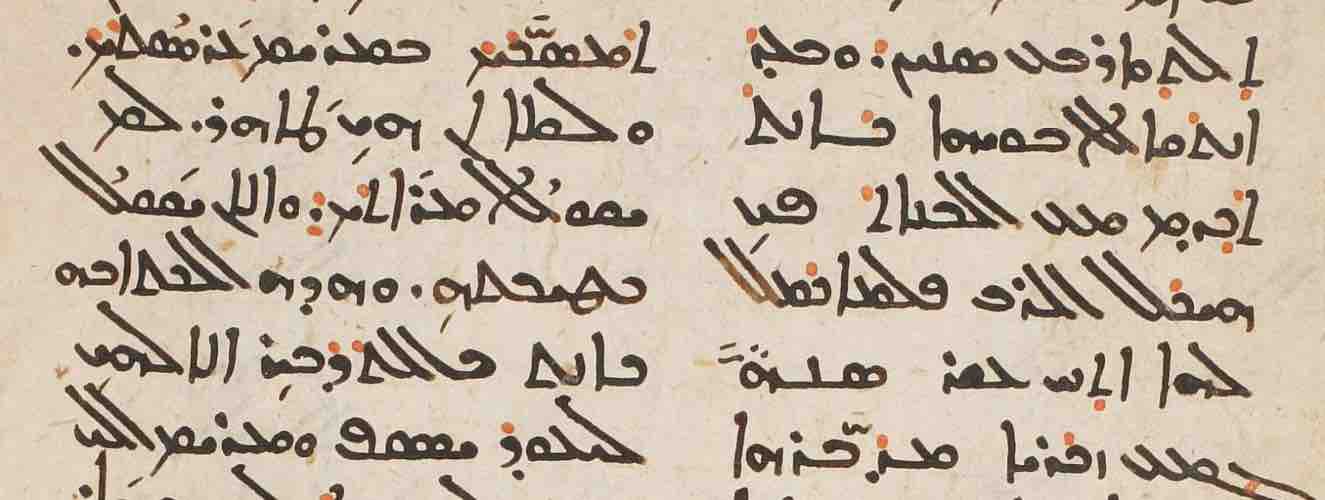Lesson
Syriac Scripts - Garshuni

Description
Syriac script used to write Arabic texts, with various approaches used to represent the more numerous Arabic letters.
Overview - Garshuni: Arabic Language in Syriac Script
This lesson is an excursus, and users who are strictly concerned with Syriac may skip it. Script and language are not linked absolutely. Garshuni presents one such disjunction. The manuscripts here in view are Arabic-language texts written in Syriac script (both Serto and East Syriac). Syriac script has been used — in manuscripts, less often in print — to record a number of languages other than Syriac (Persian, Turkish, Armenian, Georgian, etc.), but the best attested in manuscripts is Arabic. Without further qualification, the term Garshuni usually means Arabic language in Syriac script; with qualifiers (e.g., Armenian Garshuni) it is sometimes used for any language written with Syriac script. (Cf., Arabic written with Hebrew script, also well attested and known as Judeo-Arabic.) While both Syriac and Arabic belong to the Semitic family of languages and thus share some phonological similarities, there are also differences. In addition, there are well-established scribal traditions on both sides,Syriac and Arabic. On the Arabic side, a reading tradition influenced more or less by the reader's own Arabic dialect may also come into play. That is to say, there is a reading tradition that does not necessarily have Classical Arabic as its model. Syriac script, with 22 letters, has a smaller inventory of letters than Arabic script, which has 28 letters, and while scribes often use(d) diacritical marks to fill out this deficiency, the manuscripts provide ample evidence that the practice was hardly universal. Ideally there would be exact correspondence between this Syriac letter (or letter plus diacritic) and that Arabic letter, and such an ideal appears in published charts to describe Garshuni. The manuscripts, however, are not so tidy. (For further details, with many examples, see Adam Carter McCollum, “Garshuni as It Is: Some Observations from Reading East and West Syriac Manuscripts,” Hugoye 17, no. 2 (2014): 215-235. Available at Academia.edu.)
This part of the course simply offers a showcase of some Serto and East Syriac Garshuni manuscripts. The letter-forms will be easily recognized from other parts of the course. Readers should especially take note of the variety of ways that underlying Arabic graphemes may appear. There really is not a standard Garshuni.
Note: for the Academia.edu reference above, if you do not already have PDF viewer software you may download the free Adobe Acrobat Reader.
Serto Examples of Garshuni
Bzommar, BzSr 1 (dated 1289/90)
This manuscript above has texts in both Syriac and Garshuni.
Daniel b. al-Ḫaṭṭāb, The Verification of our Confession
Bzommar, BzSr 1, ff. 80v-81r.
Jerusalem, SMMJ 10 (dated 1474/5)
Psalms
Jerusalem, Saint Mark's Monastery, SMMJ 10, ff. 24v-25r. All rights reserved. Image provided by HMML.
Jerusalem, SMMJ 43 (dated 1552)
Pentateuch with Commentary
Jerusalem, Saint Mark's Monastery, SMMJ 43, ff. 18v-19r. All rights reserved. Image provided by HMML.
Aleppo, SOAA 148 (16th C.)
Bar Hebraeus, Poem on Perfection
Aleppo, SOAA 148(s), ff. 10v-11r. All rights reserved. Image provided by HMML.
Mardin, CFMM 306 (16th/17th C.)
The Story of Shapur, King of Persia
Mardin, CFMM 306, pp. 26-27. All rights reserved. Image provided by HMML.
Mardin, CFMM 256 (dated 1665)
On Jacob of Serugh and The Letter that Fell from Heaven
Mardin, CFMM 256, f. 6r/p. 8.Mardin. All rights reserved. Image provided by HMML.
Mardin, CFMM 287 (dated 1717/8)
The Story of the Apostle Andrew
Mardin, CFMM 287, pp. 13-14. All rights reserved. Image provided by HMML.
Homs, SOAH 3 (dated 1720)
Basilios Šemʿon al-Ṭūrānī, The Weapon of Religion and the Shield of Certainty
Homs, SOAH 3, f. 5r. All rights reserved. Image provided by HMML.
Mardin, CFMM 391 (dated 1722)
Basilios Šemʿon al-Ṭūrānī, The Weapon of Religion and the Shield of Certainty
Mardin, CFMM 391, pp. 25-26. All rights reserved. Image provided by HMML.
Jerusalem, SMMJ 46 (dated 1852)
Daniel of Ṣalaḥ, Commentary on the Psalms
Jerusalem, SMMJ 46, pp. 11-12. All rights reserved. Image provided by HMML.
East-Syriac Examples of Garshuni
Mardin, CCM 18 (dated 1609/10))
Wedding Rituals
Mardin, CCM 18, ff. 1v-2r. All rights reserved. Image provided by HMML.
Mardin, CCM 54 (dated 1628)
Gospel Lectionary
Mardin, CCM 54, f. 7v. All rights reserved. Image provided by HMML.
Jerusalem, SMMJ 133 (dated 1678/9)
Dialogue of Abu Qurrah and Al-Maʾmūn
Jerusalem, SMMJ 133, ff. 1v-2r. All rights reserved. Image provided by HMML.
Ready to transcribe?
Try your hand at transcribing Garshuni scripts